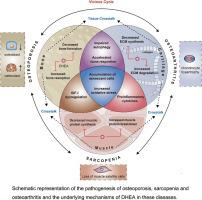Ageing Research Reviews ( IF 12.5 ) Pub Date : 2020-07-23 , DOI: 10.1016/j.arr.2020.101132 Kai Huang 1 , Hai-Li Cai 2 , Jia-Peng Bao 3 , Li-Dong Wu 3

|
Musculoskeletal disorders related to ageing are one of the most common causes of mortality and morbidity among elderly individuals worldwide. The typical constitutive components of the musculoskeletal system, including bone, muscle, and joints, gradually undergo a process of tissue loss and degeneration as a result of life-long mechanical and biological stress, ultimately leading to the onset of a series of age-related musculoskeletal diseases, including osteoporosis (OP), sarcopenia, and osteoarthritis (OA). Dehydroepiandrosterone (DHEA), a precursor of androgen secreted mainly by the adrenal gland, has attracted much attention as a marker for senescence due to its unique age-related changes. This pre-hormone has been publicly regarded as an “antidote for ageing” because of its favourable effect against a wide range of age-related diseases, such as Alzheimer disease, cardiovascular diseases, immunosenescence and skin senescence, though its effect on age-related musculoskeletal diseases has been explored to a lesser extent. In the present review, we summarized the action of DHEA against OP, sarcopenia and OA. Extensive detailed descriptions of the pathogenesis of each of these musculoskeletal disorders are beyond the scope of this review; instead, we aim to highlight the association of changes in DHEA with the processes of OP, sarcopenia and OA. A special focus will also be placed on the overlapping pathogeneses among these three diseases, and the molecular mechanisms underlying the action of DHEA against these diseases are discussed or postulated.
中文翻译:

脱氢表雄酮和与年龄有关的肌肉骨骼疾病:联系和治疗意义。
与衰老相关的肌肉骨骼疾病是全世界老年人中最常见的死亡和发病原因之一。肌肉骨骼系统的典型组成部分,包括骨骼,肌肉和关节,由于终生的机械和生物压力而逐渐经历组织丧失和变性的过程,最终导致一系列与年龄有关的疾病的发作肌肉骨骼疾病,包括骨质疏松症(OP),肌肉减少症和骨关节炎(OA)。脱氢表雄酮(DHEA)是雄激素的主要前体是由肾上腺分泌的,由于其独特的与年龄相关的变化,作为衰老的标志物已引起人们的广泛关注。这种前激素被公认为是“抗衰老药”,因为它对多种与年龄有关的疾病具有良好的疗效,诸如阿尔茨海默氏病,心血管疾病,免疫衰老和皮肤衰老之类的疾病,尽管其对与年龄有关的肌肉骨骼疾病的影响的研究程度较小。在本综述中,我们总结了脱氢表雄酮(DHEA)对OP,肌肉减少症和OA的作用。这些肌肉骨骼疾病中每一种的发病机理的详尽描述都超出了本文的范围。相反,我们旨在强调DHEA的变化与OP,肌肉减少症和OA进程之间的关系。还将特别关注这三种疾病之间重叠的病原体,并讨论或推测了脱氢表雄酮对这些疾病起作用的分子机制。尽管其对与年龄有关的肌肉骨骼疾病的影响的研究程度较小。在本综述中,我们总结了脱氢表雄酮(DHEA)对OP,肌肉减少症和OA的作用。这些肌肉骨骼疾病中每一种的发病机理的详尽描述都超出了本文的范围。相反,我们旨在强调DHEA的变化与OP,肌肉减少症和OA的过程之间的关系。还将特别关注这三种疾病之间重叠的病原体,并讨论或假定了脱氢表雄酮对这些疾病起作用的分子机制。尽管其对与年龄有关的肌肉骨骼疾病的影响的研究程度较小。在本综述中,我们总结了脱氢表雄酮(DHEA)对OP,肌肉减少症和OA的作用。这些肌肉骨骼疾病中每一种的发病机理的详尽描述都超出了本文的范围。相反,我们旨在强调DHEA的变化与OP,肌肉减少症和OA进程之间的关系。还将特别关注这三种疾病之间重叠的病原体,并讨论或假定了脱氢表雄酮对这些疾病起作用的分子机制。这些肌肉骨骼疾病中每一种的发病机理的详尽描述都超出了本文的范围。相反,我们旨在强调DHEA的变化与OP,肌肉减少症和OA进程之间的关系。还将特别关注这三种疾病之间重叠的病原体,并讨论或假定了脱氢表雄酮对这些疾病起作用的分子机制。这些肌肉骨骼疾病中每一种的发病机理的详尽描述都超出了本文的范围。相反,我们旨在强调DHEA的变化与OP,肌肉减少症和OA的过程之间的关系。还将特别关注这三种疾病之间重叠的病原体,并讨论或假定了脱氢表雄酮对这些疾病起作用的分子机制。











































 京公网安备 11010802027423号
京公网安备 11010802027423号